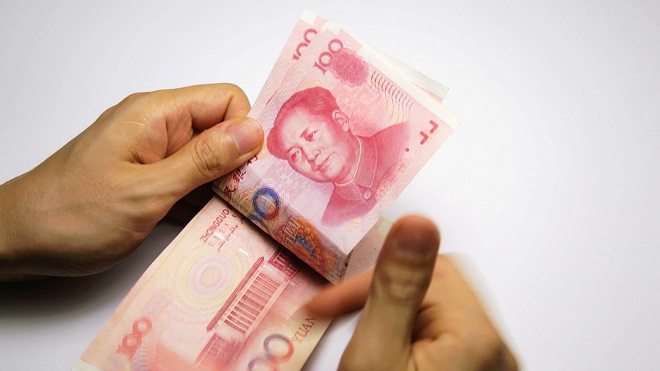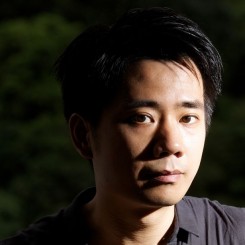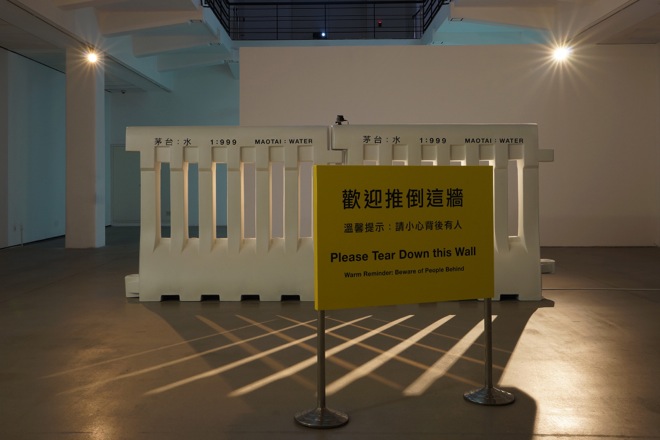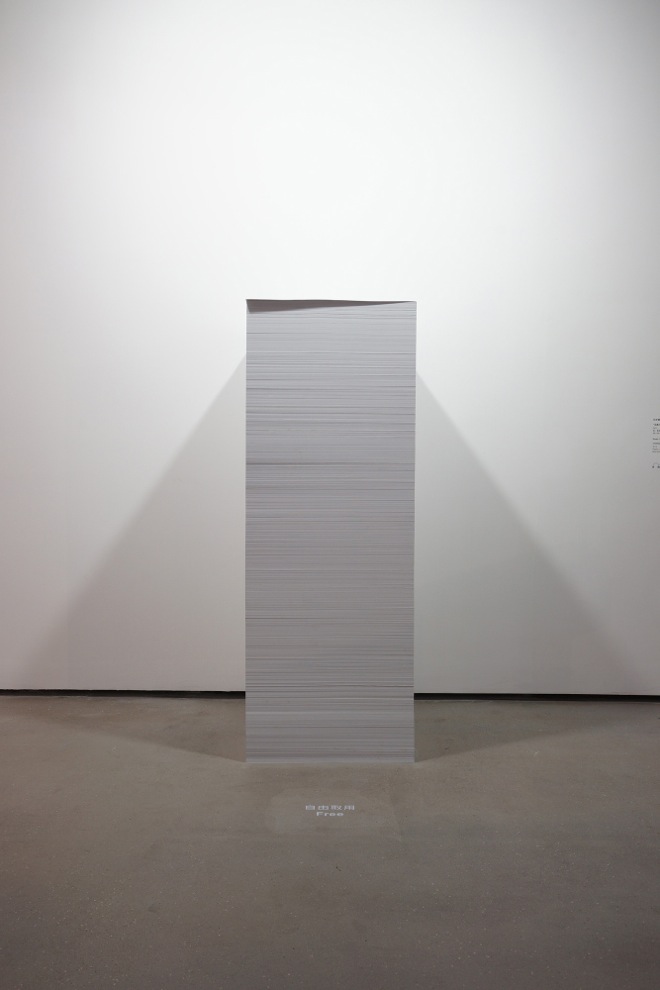Surprising even the most hardened skeptics, the inaugural Hugo Boss Asia Art Award exhibition in Shanghai presented a number of challenging and edgy works with the Hong Kong artist Kwan Sheung Chi taking home the generous sum of 300,000 RMB and the accolades and attention that go with it. The director of the Rockbund Art Museum, Larys Frogier states that Kwan Sheung Chi “combines a rich, witty and yet critical exploration of artistic social and cultural challenges…[He] is producing such artworks in a very unique and subtle way, extending and revisiting the limits of medium, and of art production and display.”
Always cutting and satirical, Kwan explore issues such as collective memory in regards to “historical events” in China (note the dimensions to “Untitled (White”), corruption, tension and instability and façades of normalcy. Bars and lines feature prominently in this show, most obviously in Kwan’s works “Water Barrier (Maotai: Water, 1:999)” which explores issues of public protest and corruption—the artwork literally reeked of Maotai, the preferred tipple of many top officials with one bottle of the liquor mixed in at a ratio of 1 part baijiu to 999 parts water. The work will be accompanied by a public performance where art goers of the Rockbund will attempt to topple the water barrier on the evening of Nov 1. We advise any interested parties to bring their Wellies.
Caustic substances come up again in his cheekily titled work “Doing It with Chi…Making and Exit Bag” and “Doing It with Mrs Kwan…Making Pepper Spray.” The videos are produced in a cheap cable television kind of aesthetic—and use a cooking show or DIY format to teach the viewer how to make pepper spray—in one scene Mrs. Kwan, dressed in her housewife uniform, remarks that the pepper spray contains Western, Chinese and Japanese flavors, “something for everyone’s taste.” While in “Exit Bag”, Kwan advises the viewer that in order to improve the aesthetics of the suicide one should get their hair done before donning a suffocation bag.

Kwan Sheung Chi, “Doing It with Mrs Kwan…Making Pepper Spray”,single-channel video; HD, color, mono sound, 5 mins 16s, 2012
Yet Kwan is only one of the many artists producing deep and challenging work. The jury had much to discuss, says Frogier: “The main debate was driven to the different ways artists were critically questioning, displaying and revisiting some social contexts in China by raising also new art languages into the international art scene.”
The finalists’ exhibition also featured a strong showing by Li Liao with a piece dealing with the issue of how artists fare in a society where money is the prime indicator of status. The inspiration came from Li’s personal experience—in fact, his relationship with his girlfriend, which was concealed from his girlfriend’s parents until she became pregnant. Li’s father-in-law visited and the artist and turned this little slice of family drama into a work that consisted of a dialog between the father and son in law—a ripped sweater and broken remote control from the scuffle and a donation of RMB 40,000 RMB (taken from the production fees) to the father-in-law as proof that Li was able to earn a living wage.
Hsu Chia Wei, from Taiwan, also produced some challenging works dealing with issues of identity, history and memory with his work, “Huei-Mo Village” in which the artist visited a village in Thailand inhabited by a band of displaced KMT soldiers of the Republic of China army. These troupes were supposed to bring up the rear but instead were stranded in Yunnan after 1950 where they fled to Burma and fought against the Burmese for years, until they eventually moved to Thailand and obtained citizenship in return for protecting the Thai border. Many locals were also involved in the drug trade as the area is close to the Golden Triangle. Many were sentenced for drug offenses leaving a large number of orphans behind. Hsu created a fictional film with the orphans and a model of an army barracks with former soldiers working in close collaboration with these communities.
With Hsu and with most of the participants, we can find a strong sociopolitical engagement, which is refreshing to see. This is no doubt a result of the eclectic jury which involves many respected figures in the art world—both independent curators, or those working at independent spaces, mixed in with those in the employ of prestigious institutions. These include Biljana Ciric (independent curator), Cosmin Costinas (Para/Site, Hong Kong), Yuko Hasegawa (chief curator of Museum of Contemporary Art, Tokyo), Alexandra Munroe (senior curator of Asian Art at the Guggenheim, New York), Pauline Yao (Curator at M+, Hong Kong) and the Beijing-based artist Peng Yu.
Both the jury and the museum made a conscious effort to spotlight art from Taiwan and Hong Kong — overlooked corners of the Chinese contemporary art world. “It is decisive to highlight some areas and art practices in the endless process of remapping art and in the remaking of contemporary history,” says Frogier, “It could be related to Hong Kong and Taiwanese artists, but it is also strongly connected to the young mainland Chinese artists who are confronting today and striving for new visibilities in the art institutions.”
_________________________
Hugo Boss Asia Art finalists’ exhibition
Rockbund Art Museum (20 Huqiu Road, Huangpu District, Shanghai) Sep 13–Dec 8, 2013

Kwan Sheung Chi, “Doing it with Chi…Making an Exit Bag”, single-channel video; HDV, color, stereo sound, 3 mins 44s, 2009

Kwan Sheung Chi, “ONE MILLION (Renminbi)”, single-channel video; HD, color, mono sound, 1hour 20 mins 24s, 2013




